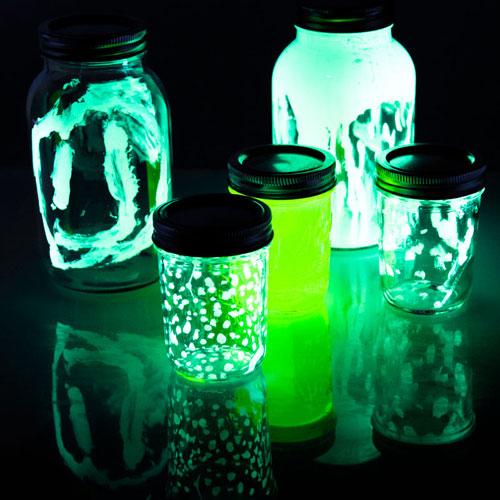Have you caught fireflies in a jar on a warm summer night? It’s magic to watch the little bugs flash their taillights as they buzz around in the dark. But fireflies are not readily available in all areas of the United States. Here’s a fun and easy activity to make your own firefly glowing jars while learning the science of glow.

Here's What You'll Need
-
Small or large Mason jars with lids
-
Glow Powder (Zinc Sulfide)
-
Atomic Glow
-
Elmer's Glue
-
Paint brush or cotton swab
-
Black light (if using Atomic Glow)
Experiment
This experiment is quick and easy.
- Wash your Mason jars so they are clean of any debris
- Mix the Atomic Glow or Glow Powder with Elmer’s glue. Make sure there is enough power or dye to make the glue substance glow under a black light.
- Stick the paint brush or cotton swab into the glowing glue and paint inside the jar. Make dots, paint pictures, drip it along the sides and let it run down.
- Let dry
- If you used Glow Powder, charge the jar under any type of light – sunlight, flashlight, lightbulb – then turn off the lights. The jar will glow for a few minutes.
- If you used Atomic Glow, this dye will only glow under a black light. Place your jar next to or on top of the black light and turn it on.
- Wait for ooohs and ahhhs.
ACTIVITY TIME:
Allow about 20 to 30 minutes for this activity. It takes about 5-10 minutes to set up, and depending on the complexity of your glow designs, painting can take 2 to 20 minutes to complete. Let dry for at least 30 minutes before touching. Lids can be replaced and jars will glow right away.
How Does It Work?
Before you get started, you must understand the difference between the Zinc Sulfide Glow Powder and Atomic Glow Concentrate, or the terms fluorescence and phosphorescence.
It’s also important to note that not all zinc sulfide glows, but luminous zinc sulfide does glow!
Fluorescence
This type of luminescence occurs when some form of radiation, such as light, causes an object to glow. For example, fluorescent papers and poster boards glow in the daylight. They glow even brighter under black light (ultraviolet light). Ultraviolet light is a component in sunlight. Ultraviolet wavelengths are very long with a very high frequency and can be used to detect fluorescent material that would remain invisible under normal conditions. When you shine ultraviolet light on fluorescent material, it lights up with a beautiful bluish-green luminescence.
In either case, as soon as the light is removed, the glow stops. Fluorescent things do not glow in the dark all by themselves – they require some other form of energy such as ultraviolet light to “excite” them.
Under normal light, Atomic Glow will turn water a cool greenish-yellow color. Under a black light, the goo actually glows an eerie green color. Atomic Glow is fluorescent and needs a black light to make it glow.
Parents – also note that Atomic Glow will stain.
Phosphorescence
Phosphorescence is just like fluorescence, except that the glow continues even after the light used to excite it is removed. “Glow in the dark” toys phosphoresce brightly in total darkness after being “charged” or excited by ordinary white or ultraviolet light. Glow Powder works by absorbing surrounding light energy and then releases that energy when the lights go out. It’s called a phosphorescent.
So, how does zinc sulfide work? Imagine that an atom looks something like our solar system. The sun would be the nucleus consisting of positive charges called protons and neutral charges called neutrons. The planets spinning around the sun would be similar to the electrons of an atom in orbits around the nucleus.
When the electrons in the atoms of special molecules like zinc sulfide become excited, they move farther away from the nucleus — into higher or more distant orbits. In order to become excited, the electrons must take on energy. In this case, light provided the required energy to cause the electrons to move to a higher energy level. It’s as if Earth were to move farther away from the sun into the orbit of Mars or Jupiter.
The electrons will remain in the excited state as long as they receive light to energize them. But, when the light used as an exciter is removed, the electrons will slowly return to their original lower orbits. As they do so, they give up the energy that excited them in the form of light.
Glow Sticks
Glow sticks are yet another way that materials can glow in the dark. Glow sticks create their glow through a chemical reaction between different chemicals. The light that this chemical reaction produces is called chemiluminescence. Just like the other two types of materials, you can see chemiluminescent materials the best in the dark.
